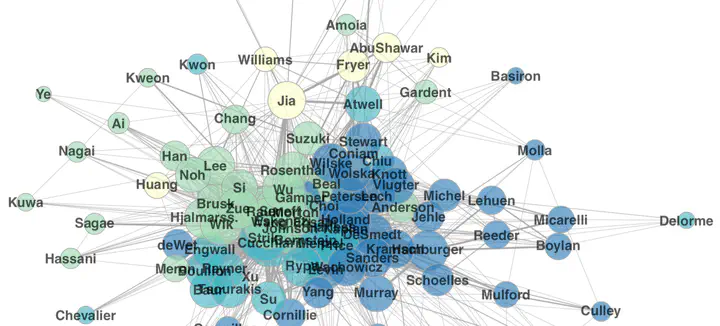Discussing with a computer to practice a foreign language: Research synthesis and conceptual framework of dialogue-based CALL
 Co-citation network graph of authors of dialogue-based CALL publications
Co-citation network graph of authors of dialogue-based CALL publicationsAbstract
This article presents the results of a systematic review of the literature on dialogue-based CALL, resulting in a conceptual framework for research on the matter. Applications allowing a learner to have a conversation in a foreign language with a computer have been studied from various perspectives and under different names (dialogue systems, conversational agents, chatbots…). Considering the fragmentation of what we identify under the term dialogue-based CALL, we attempt to offer a structured overview of these efforts into a conceptual framework. Through a methodical search strategy, we collected a corpus of 343 publications. From this corpus, we formalized an operational definition of dialogue-based CALL, which allowed us to identify 96 relevant systems. Analysing the type of dialogue they offer, on a continuum of constraints on form and meaning, we propose to classify those systems into four groups. We have called these branching, form-focused, goal-oriented and reactive systems, and we describe their corresponding interactional, instructional and technological traits. We summarize the main results from empirical studies on such systems, distinguishing observational, survey and experimental studies, and discuss the impact of dialogue-based CALL on motivation and L2 development, identifying positive evidence on both outcomes. Finally, we propose two main avenues for future research: relative effectiveness of dialogue-based CALL approaches, and dialogue systems as an environment for testing SLA hypotheses.
Plain language summary
Practice a Foreign Language by Talking to a Bot:
Synthesis of Research and Systems
What is it about?
We summarize the efforts done in academia since the 1980s to use computers and automated systems to help learners practice a foreign language meaningfully. These include talking robots, text interactions with chatbots, and spoken conversations with dialogue systems. We propose a conceptual framework for all these efforts and a typology of systems, reviewing their main contributions. Finally, we synthesize the results of previous studies on how effective these systems are for learning a language.
Why is it important?
This is the first comprehensive review of all the systems using dialogue with an automated agent (robot, chatbot, dialogue system, conversational agent, non-player character…) to learn a foreign language.
My perspective
I believe our definition, inclusion of all key terms used to describe these systems, and discussion of the different features and characteristics of systems are providing a clearer picture of the domain for researchers and developers. The typology we propose can probably be simplified and summarized into the 4 main types of systems (more usable than the 7 types of dialogues). Our review of previous studies on effectiveness is offering an adequate summary of what we know works, for what, and for whom. Our to-be-published meta-analysis of dialogue systems for language learning (in Language Learning & Technology, 2022, but available as a preprint) offers a more precise quantitative evaluation of these effects.
Typology of dialogue-based CALL dialogues and systems
This is the full typology of dialogue-based CALL 7 types of dialogues, as presented in the paper:

In subsequent publications (e.g., Bibauw et al., 2022a [meta-analysis], 2022b), for simplicity’s sake, we retained only the level of systems, considering only 4 types: narrative systems, form-focused systems, goal-oriented systems and reactive systems.
Supplementary Annexes
- Appendix I: Complete list of publications collected for this study (343 publications)
- Appendix II: List of publications on dialogue-based CALL, with all coded variables (207 publications)
- Appendix III: List of dialogue-based CALL systems, with all coded variables (96 systems)
- Appendix IV: Coding scheme for publications
- Appendix V: Coding scheme for systems